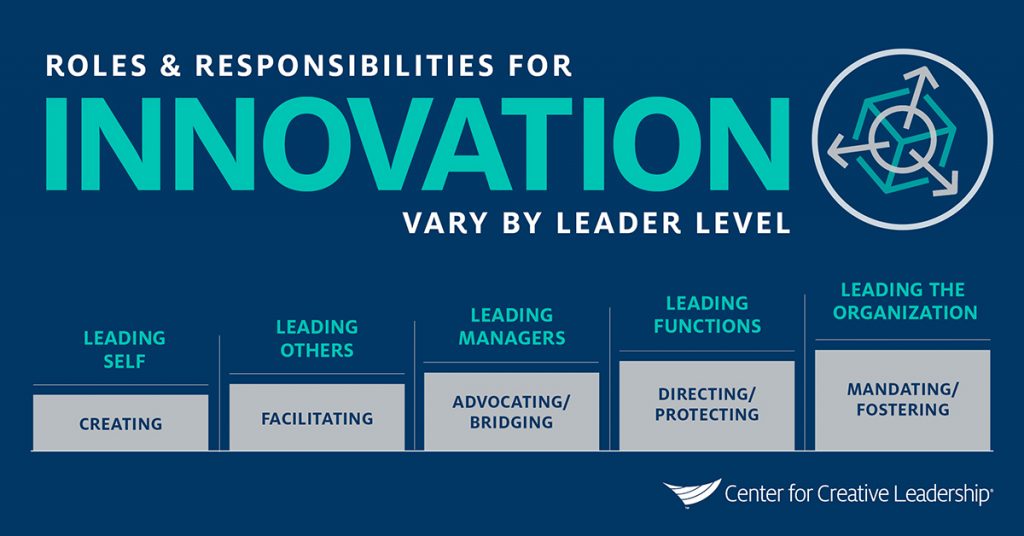Driving Innovation at Every Level of the Org Chart
It’s obvious that leaders at different levels of the organization have to lead differently — think about how different the leadership challenges are for a line supervisor than a CEO.
So it shouldn’t be surprising that leaders who are looking to drive innovation have different challenges depending on their position. There isn’t a one-size-fits-all solution.
Regardless of where you sit in an organization, it’s useful to understand the challenges unique to leading innovation efforts — and the 3 leadership imperatives that provide emotional support innovators need.
Understand Your Role in Innovation
Unsure where you stand on pushing innovation forward? Consider where you sit in the organization. Innovation at every level looks different. Here’s a rundown of the roles and responsibilities, by leader level, specific to innovation to get you started:
5 Key Innovation Leadership Roles
Leading Self: Creating
At the level where you don’t have direct reports — where you’re an individual contributor, maybe serving as a role model, or perhaps a leader of project teams — the responsibilities around innovation fall mainly into the realm of knowing how to generate creative solutions and having a keen interest in participating on a team made up of diverse talent.
Core to this is the ability to find sources of inspiration for new approaches, whether that means looking at other industries, engaging customers and stakeholders, or exploring patent databases for similar challenges that have been solved by others.
Basically, at this level, your role in innovation is that you’re responsible for ideation and creation, generating novel solutions to challenging problems.
Leading Others: Facilitating Innovation
Team leaders or line supervisors need to possess additional skills. They must know how to lead the group process, which requires special facilitation skills on top of those necessary for being an effective team leader or project manager.
And for innovation to take root and spread through the organization, these leaders or supervisors need to know how to obtain resources from outside their units to support the work of innovation.
At this level, your role in innovation is about leading group processes that support innovation and obtaining resources to support your team’s efforts.
Leading Managers: Advocating/Bridging Innovation
When you lead people who are leading others, a key value you bring to the challenge of innovation is supporting and protecting the team from superiors or other parts of the organization.
Great leaders create a protective umbrella over their people to ensure that the discomfort, risk, and potential disruption of the business don’t cause others to try to shut down these efforts. These managers also have to know how to build a case for grassroots innovation and how to bridge groups that are working on similar challenges to ensure constructive cooperation.
At this level, your role in innovation is facilitating cooperation between groups working on similar opportunities.
Leading Functions: Directing/Protecting Innovation
Leaders of a function or significant silo need to provide clear direction for the scope of the innovation efforts and also need to manage conflicting demands for resources. They must initiate strategic and structural changes to accommodate promising innovations and establish a strategy that bridges the silos.
As if that’s not enough, they are critical to modeling behavior and driving communication that sets the organizational tone that determines broader support of innovation. They’re also critical in the management of the innovation pipeline and balancing the portfolio “bets” that help determine the future direction of the organization’s innovation. Consider how you respond to new ideas and whether you foster innovative mindsets on your team.
At this level, your role in innovation is knowing how to develop the innovation strategy and manage the pipeline of new products and services, while bridging silos in the organization.
Leading the Organization: Mandating/Fostering Innovation
Finally, we have the top of the organization. These are the people who have the critical job of setting a strategy to ensure that the organization has a clear direction on where it’s going.
More than that, they are the keystone for fostering a culture of innovation, a big part of which is modeling behaviors to ensure that the walk matches the talk, which sometimes means showing support for different, new, or disruptive ideas.
Like other top leadership responsibilities, it’s imperative that they know how to communicate the vision over and over and over again. And at this level, it’s critical you avoid subconsciously sabotaging innovation. Perhaps the hardest job is finding ways to hear and see unfiltered concepts, since the further you go up the hierarchy, the less connected to “what’s really true” you become.
At this leader level, your role in innovation is shaping the organizational culture to support innovation.
Regardless of Your Role in Innovation, Leading It is Challenging
Regardless of their position in the organization, individual leaders tasked with leading innovation efforts — either because that’s a part of their role or because they’re responsible for the day-to-day management of a specific innovation project — will have different leadership challenges.
Why? Because leading innovation is distinctly different than leading ongoing business operations. Leading innovation is different than leading in general in 4 critical ways:
- Not only are outcomes uncertain, but the entire context of the innovation process is uncertain. Leaders can’t be sure if innovators are even pursuing the right general ideas.
- Innovation is risky and failures are common, even likely. There can be dramatic ups and downs over the course of an innovation project.
- It’s high profile. Typically, innovation efforts are among the most visible in the entire organization.
- It’s uncharted territory. Innovators are unable to follow an established path in their work. They don’t know where the road will take them, how long it will take to get there, or even how valuable their destination may be.
For those involved in the day-to-day work of innovation, these differences mean their work takes a greater emotional toll than work in ongoing operations does. To sustain their innovation efforts over long periods of time and take the risks necessary for successful innovation, leaders must provide greater emotional support to their innovation teams.
3 Innovation Leadership Imperatives
Learn What Innovation Leaders Do
To understand this emotional support, we conducted interviews with individuals (and their bosses) who have a track record of managing multiple successful innovation projects. Based on these interviews, we discerned 3 leadership imperatives that provide the essential emotional support that innovators need:
1. They demonstrate trust to empower.
Those involved in the day-to-day work need to know that their leaders trust their talents, their efforts, and the decisions they are making. That demonstrated trust allows innovators to trust themselves amidst the inherent ambiguity of their work.
2. They keep purpose front-and-center to motivate and inspire.
Effective leaders keep the attention of their direct reports focused on the benefits that can ultimately come from the innovation project. It’s easy for innovators to lose the horizon, and therefore motivation. Those doing the innovation work need to know that what they’re doing is important and valuable.
3. They act as equal partners to share the risk and the outcome.
In innovation, no one knows the answers, and no one can be sure of the right direction, so the traditional hierarchical leader-follower relationship is not as helpful. Good innovation leaders, when appropriate, are willing and able to sit with their innovation teams as equals and contribute to the effort not as the boss, but as a member of the team. Being an equal partner also demonstrates the boss’s commitment to innovation. This way, they share the risk and the outcome so that the people driving innovation aren’t in it alone.
Ready to Take the Next Step?
Build your team’s capacity for fostering innovation at every level with a customized learning journey for your leaders using our research-backed modules. Available leadership topics include Leading Through Change & Disruption, Emotional Intelligence, Innovation Leadership, Listening to Understand, Psychological Safety & Trust, and more.








